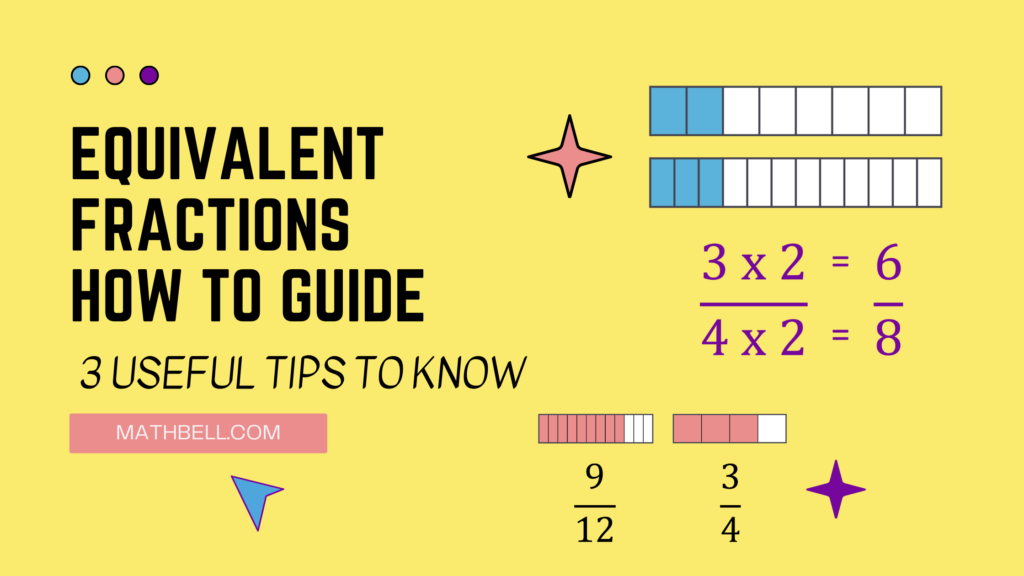Understanding what equivalent fractions are and how to find them or determine if fractions are equivalent is a part of the foundation of solving problems involving fractions.
They are especially important to know when adding, subtracting, or simplifying fractions.
So what are equivalent fractions?
In this How to Guide, you will learn exactly what equivalent fractions are, when to teach them, and different ways to go about teaching them so that you meet the needs of all of your students.
What are equivalent fractions?
Equivalent fractions are any fractions that represent the same amount or quantity but have different sized parts. ½ and 4/8 are equivalent fractions. They cover the same amount of space in an area model or end at the same point on a number line.
Examples for Equivalent Fractions
To demonstrate, we will take a look at what fractions are equivalent to each other and how to find more.
First let’s check out this list of common equivalent fractions:
| Fractions Equivalent to 1/2 | 2/4 | 3/6 | 4/8 | 5/10 | 6/12 | 7/14 | 8/16 | 9/18 | 10/20 | 11/22 | 12/24 | 13/26 |
| Fractions Equivalent to 1/3 | 2/6 | 3/9 | 4/12 | 5/15 | 6/18 | 7/21 | 8/24 | 9/27 | 10/30 | 11/33 | 12/36 | 13/39 |
| Fractions Equivalent to 1/4 | 2/8 | 3/12 | 4/16 | 5/20 | 6/24 | 7/28 | 8/32 | 9/36 | 10/40 | 11/44 | 12/48 | 13/52 |
| Fractions Equivalent to 1/5 | 2/10 | 3/15 | 4/20 | 5/25 | 6/30 | 7/35 | 8/40 | 9/45 | 10/50 | 11/55 | 12/60 | 13/65 |
| Fractions Equivalent to 1/6 | 2/12 | 3/18 | 4/24 | 5/30 | 6/36 | 7/42 | 8/48 | 9/54 | 10/60 | 11/66 | 12/72 | 13/78 |
| Fractions Equivalent to 2/3 | 4/6 | 6/9 | 8/12 | 10/15 | 12/18 | 14/21 | 16/24 | 18/27 | 20/30 | 22/33 | 24/36 | 26/39 |
| Fractions Equivalent to 2/5 | 4/10 | 6/15 | 8/20 | 10/25 | 12/30 | 14/35 | 16/40 | 18/45 | 20/50 | 22/55 | 24/60 | 26/65 |
| Fractions Equivalent to 3/4 | 6/8 | 9/12 | 12/16 | 15/20 | 16/24 | 21/28 | 24/32 | 27/36 | 30/40 | 33/44 | 36/48 | 39/52 |
| Fractions Equivalent to 3/5 | 6/10 | 9/15 | 12/20 | 15/25 | 18/30 | 21/35 | 24/40 | 27/45 | 30/50 | 33/55 | 36/60 | 39/65 |
| Fractions Equivalent to 4/5 | 8/10 | 12/15 | 16/20 | 20/25 | 24/30 | 28/35 | 32/40 | 36/45 | 40/50 | 44/55 | 48/60 | 52/65 |
| Fractions Equivalent to 5/6 | 10/12 | 15/18 | 20/24 | 25/30 | 30/36 | 35/42 | 40/48 | 45/54 | 50/60 | 55/66 | 60/72 | 65/78 |
| Fractions Equivalent to 1/8 | 2/16 | 3/24 | 4/32 | 5/40 | 6/48 | 7/56 | 8/64 | 9/72 | 10/80 | 11/88 | 12/96 | 13/104 |
| Fractions Equivalent to 3/8 | 6/16 | 9/24 | 12/32 | 15/40 | 18/48 | 21/56 | 24/64 | 27/72 | 30/80 | 33/88 | 36/96 | 39/104 |
| Fractions Equivalent to 5/8 | 10/16 | 15/24 | 20/32 | 25/40 | 30/48 | 35/56 | 40/64 | 45/72 | 50/80 | 55/88 | 60/96 | 65/104 |
| Fractions Equivalent to 7/8 | 14/16 | 21/24 | 28/32 | 35/40 | 42/48 | 49/56 | 56/64 | 63/72 | 70/80 | 77/88 | 84/96 | 91/104 |
| Fractions Equivalent to 1/10 | 2/20 | 3/30 | 4/40 | 5/50 | 6/60 | 7/70 | 8/80 | 9/90 | 10/100 | 11/110 | 12/120 | 13/130 |
| Fractions Equivalent to 3/10 | 6/20 | 9/30 | 12/40 | 15/50 | 18/60 | 21/70 | 24/80 | 27/90 | 30/100 | 33/110 | 36/120 | 39/130 |
| Fractions Equivalent to 7/10 | 14/20 | 21/30 | 28/40 | 35/50 | 42/60 | 49/70 | 56/80 | 63/90 | 70/100 | 77/110 | 84/120 | 91/130 |
| Fractions Equivalent to 9/10 | 18/20 | 27/30 | 36/40 | 45/50 | 54/60 | 63/70 | 72/80 | 81/90 | 90/100 | 99/110 | 108/120 | 117/130 |
| Fractions Equivalent to 1/12 | 2/24 | 3/36 | 4/48 | 5/60 | 6/72 | 7/84 | 8/96 | 9/108 | 10/120 | 11/132 | 12/144 | 13/156 |
| Fractions Equivalent to 5/12 | 10/24 | 15/36 | 20/48 | 25/60 | 30/72 | 35/84 | 40/96 | 45/108 | 50/120 | 55/132 | 60/144 | 65/156 |
| Fractions Equivalent to 7/12 | 14/24 | 21/36 | 28/48 | 35/60 | 42/72 | 49/84 | 56/96 | 63/108 | 70/120 | 77/132 | 84/144 | 91/156 |
| Fractions Equivalent to 11/12 | 11/24 | 22/36 | 33/48 | 44/60 | 55/72 | 66/84 | 77/96 | 88/108 | 99/120 | 110/132 | 121/144 | 132/156 |
So how do we know those examples are equivalent?
How can we start with one fraction and find fractions that are equivalent to it?
What should you think about or focus on when teaching this skill to your students?
This guide will answer those questions for you!
What grade do students learn equivalent fractions?
Students are introduced to equivalent fractions in grade 3, they extend that understanding in grade 4 , and apply their learning to add and subtract fractions with unlike denominators in grade 5.
Students develop more of an understanding of determining if fractions are equivalent and coming up with other simple equivalent fractions through visual models in grade 3. They will also find fractions that are equal to whole numbers.
They will create concrete models using fraction strips, fraction tiles, cuisenaire rods, and even pattern blocks to do this.
Watch:
Elementary Math Support| Explore Fractions and Equivalent Fractions Using Pattern Blocks
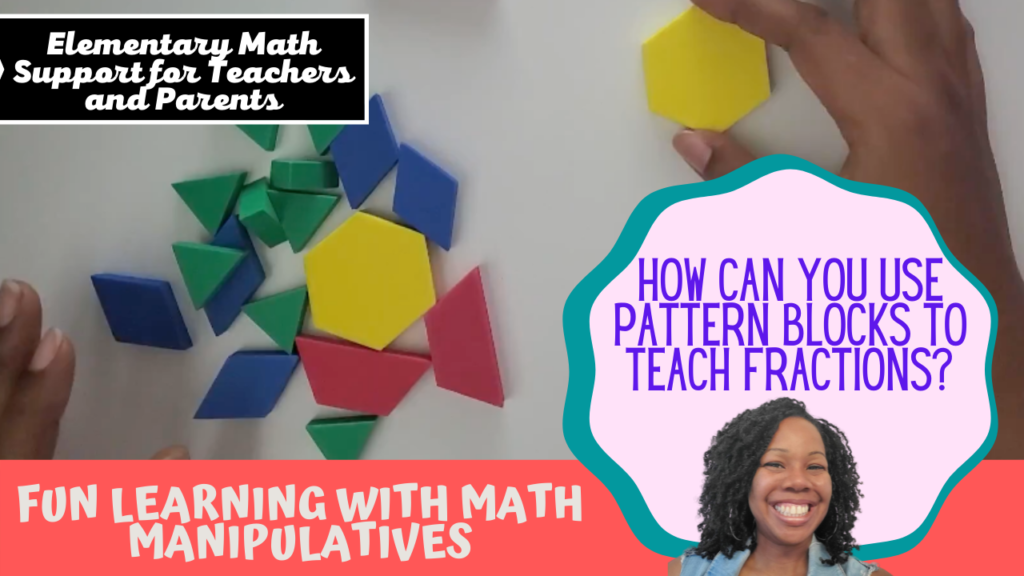
You and/or your students can even create your own fraction strips kit to use throughout multiple fraction lessons.
Watch now: Elementary Math Resources | Make Fraction Strips for Grade 3 or Grade 4 Math Students

In grade 4, the use of visual fraction models is still emphasized.
However the focus is now on explaining why those fractions are equivalent by looking at the number of parts and the size of the parts included.
After having the experience of working with equivalent fractions in the previous two grades, the goal in grade 5 is to apply that understanding and knowledge in order to add and subtract fractions (or mixed numbers) with unlike denominators.
Once students see that their fractions don’t have like denominators, they should be able to generate, or come up with equivalent fractions.
They will need to find equivalent fractions for one or both of the original fractions.
This is so that the denominators will be alike and then they can add their two fractions together.

Next we’re going to dive into how to represent and find equivalent fractions using models and an algorithm.
Before we get into those representations, I want you to keep these three things in mind while you are teaching your students.
3 Useful Tips to Know about Teaching Equivalent Fractions
- Provide enough meaningful experiences
- Make connections between models and the algorithm
- Plan for plenty of practice time
Provide Enough Meaningful Experiences
Give students many opportunities to determine if fractions are equivalent or find additional equivalent fractions through common and relatable experiences.
Talk about sharing whole amounts of food or objects amongst classmates, friends, or family.
Use cookies, cakes, brownies, pie, paper, rope, ribbon, string, yarn, fabric and other examples such as these to help your students imagine those items actually being partitioned, or cut into equal parts.
Types of questions or prompts to ask or present can include:
- Choosing the right answer through multiple choice
- Choosing a side through true/false, yes/no, or agree/disagree questions
- Showing what they know by filling in the blank or providing short answers
One of my favorites would be the agree or disagree questions where students are presented with two opposing pieces of information and they have to decide which is correct based on what they know about the topic, in this case, equivalent fractions.

Make Connections Between Models and the Algorithm
Yes students can always memorize the algorithm for a quick way to find equivalent fractions if you just teach it to them.
However, making connections to the models that they’ve been working on previously will make the meaningful experiences they’ve had so far stick even more.
Plan for Plenty of Practice Time
Most likely once you get to this concept in grade 3, a good amount of your students are still processing what fractions exactly are.
This is a very tall task for 3rd graders who are usually 8 or 9 year olds.
So far, they have been taught how to read them, say them, write them, identify and draw them in a model or on the number line.
Now you want them to decide if two fractions are the same but with different numbers.
They can do it. It just takes time.
This is also the case for students in grade 4. In grade 4 students are still working to explain why some fractions are equivalent using visual models and making connections to the number and size of parts.
The size of the fraction parts get extended to include fifths, tenths, and twelfths.
With more practice with visual models and a variety of examples, students will begin to pick up on patterns that lend themselves to the multiplication or division algorithm for finding, or generating, more equivalent fractions.
How to find Equivalent Fractions
Watch:
Equivalent Fraction Models

Since we know that equivalent fractions are fractions that represent the same amount or quantity but with a different number of parts, we can look for, or create, different models of fractions that do just that.
They have a different number of parts but represent the same amount.

In this model, the top picture represents 2/8.
The bottom picture represents 3/12.
They are two fractions with a different number of parts but they represent the same amount or quantity.
Ok so we’ve identified why these two fractions are equivalent.
What about starting with one fraction and then finding an equivalent fraction?
In this next picture model, the fraction ¾ is represented.

If we partition each part, or fourth in half by drawing a line down the middle, those parts become smaller in size.
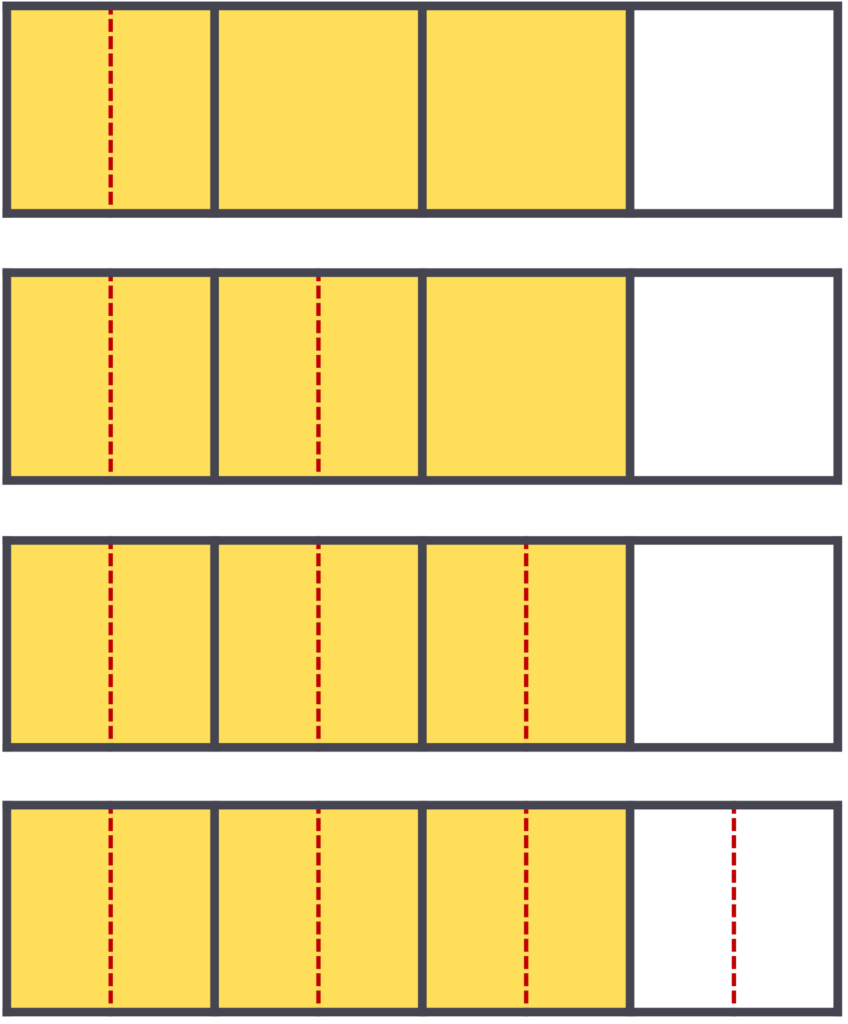
However, the shaded part of the whole stays the same.

Now instead of four equal parts, there are eight equal parts.
What fraction is represented now?
6/8
3/4 is equivalent to 6/8.
Watch:
Equivalent Fraction Algorithm

Before we talk about the algorithm, it’s important that I mention that the goal is for students to discover the algorithm and how it works rather than you just teaching it to them
This can be done through having discussions about any patterns they notice while exploring equivalent fractions.
One teacher tip is to have students record their observations in their math notebook or journal as they are working with concrete or picture models.
Let’s use the example from before.
The first model shows three fourths so we can write out the numerals for the fraction, 3/4.
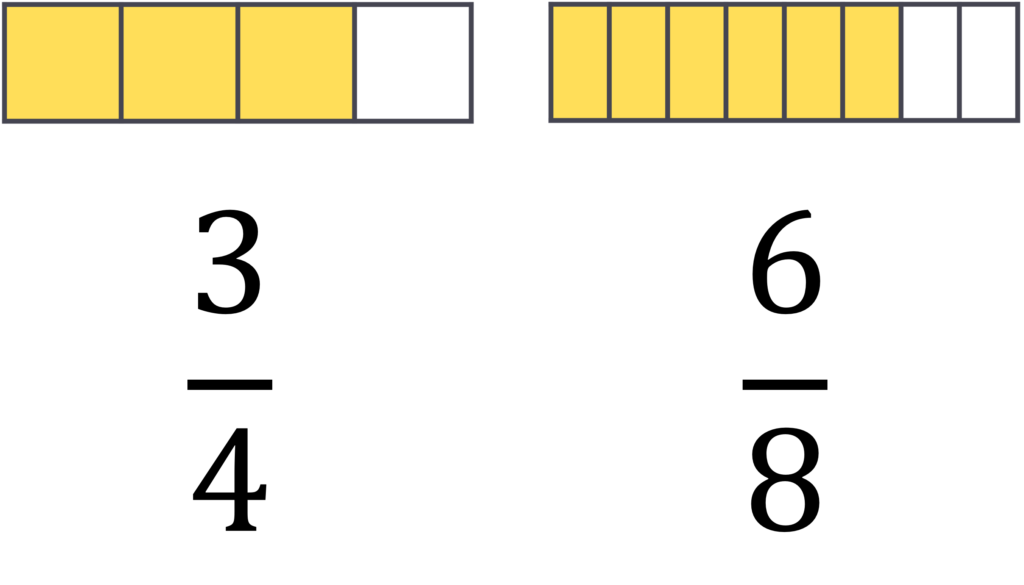
The second model shows six eighths, so we can write it as 6/8.
Focus on the denominators.
What does it take to go from 4 to 8?
We can add 4 more or we can multiply by 2.
Looking back at the model, each fourth, or equal part was split in two.
So for each 1 part, we now have two.
So it makes more sense to multiply 4 by 2 to get 8 rather than add 4.
Okay, now look at the numerators.
The first model starts with 3 parts shaded in and now in the second model, there are 6 parts shaded in.
What does it take to go from 3 to 6.
If we think about this the same way we did with the 4, it will make more sense to multiply the 3 by 2.
So in this example, both the total number of equal parts and the numbers of shaded parts were doubled, or multiplied by 2.
We can represent that as an equation.

order to find the equivalent fraction 6/8.

How can you find equivalent fractions using division?
Find Equivalent Fractions by Dividing
9/12 is equivalent to 3/4.
How is that so?
Let’s take the fraction 9/12.
Looking a the model of a whole partitioned into 12 equal parts.
Out of the 12 equal parts, 9 are shaded in.

First let’s group an equal amount of the parts inorder to represent another fraction that takes up the same amount of space.

The model shows that groups of 3 equal parts are outlined in blue.
When we focus on those groups, how many groups are there?
4 groups.

How many groups are shaded in?
3 groups out of the 4 total groups are shaded.
Again, this shows how 9/12 is equivalent to 3/4.
Let’s look at it with the algorithm using division instead of multiplication.

Beginning with the denominators.
What does it take to go from 12 to 4?
In the model, the twelfths were sectioned into groups of 3/12.
So for every 3 twelfths, we now have 1 group.
To go from 12 to 4, we have to divide twelve by 3.
Okay, now look at the numerators.
The first model shows 9 parts shaded in and the second model shows there are 3 parts shaded in.
What does it take to go from 9 to 3.
If we think about this the same way we did with the 12, it will make sense to divide 9 by 3.
9 divided by 3 equals 3.
So in this example, both the total number of equal parts and the number of shaded parts were divided by 3.
We can represent that as an equation.


In order for students to notice these patterns, they will need to be given a lot of examples to work with and a lot of opportunities to practice.

Some of the links below may be affiliate links. At no extra cost to you, I may earn a small commission based on purchases made through the links.
Activities for Equivalent Fractions
A great text resource that provides for even more explanation and activities for practicing with equivalent fractions is the book Elementary and Middle School Mathematics Teaching Developmentally by Van De Wall, Karp, and Bay-Williams.
In the tenth edition, they share different activities that you can use with a small or whole group of students in order to practice finding equivalent fractions for both third and fourth grade students.
Using Math Manipulatives
Using math manipulatives for exploration should definitely be your starting point with third and fourth grade students.
Remember that both sets of standards call for the use of visual models.
If you haven’t watched these videos yet on how to explore equivalent fractions using cuisenaire rods, pattern blocks, or fraction tiles, then check them out here.
Cuisenaire Rods – Explore fractions using cuisenaire rods
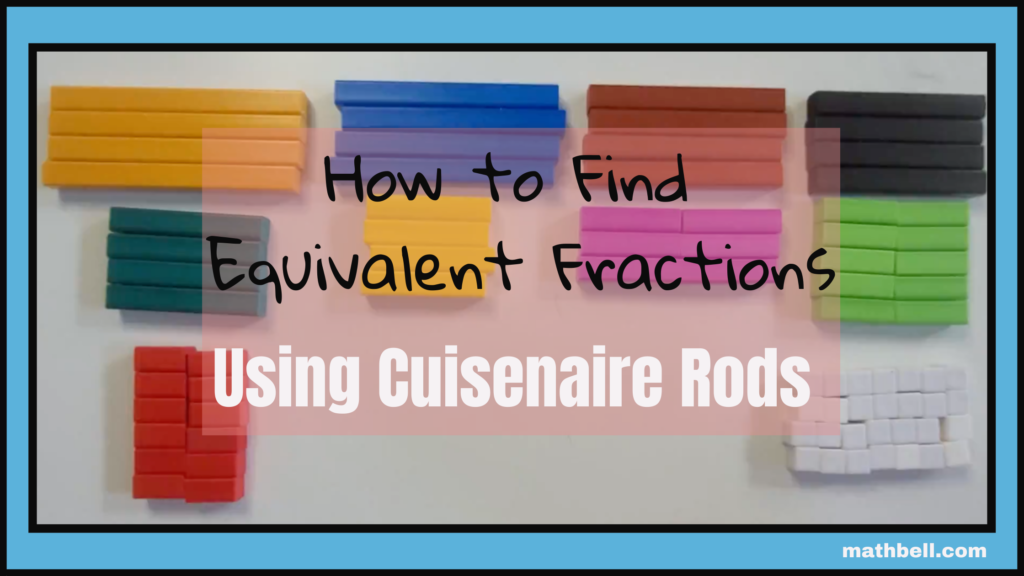
Or read the article, How to Find Equivalent Fractions Using Cuisenaire Rods.
Pattern Blocks – Explore fractions using pattern blocks

Fraction Tiles – Explore fractions using fraction tiles
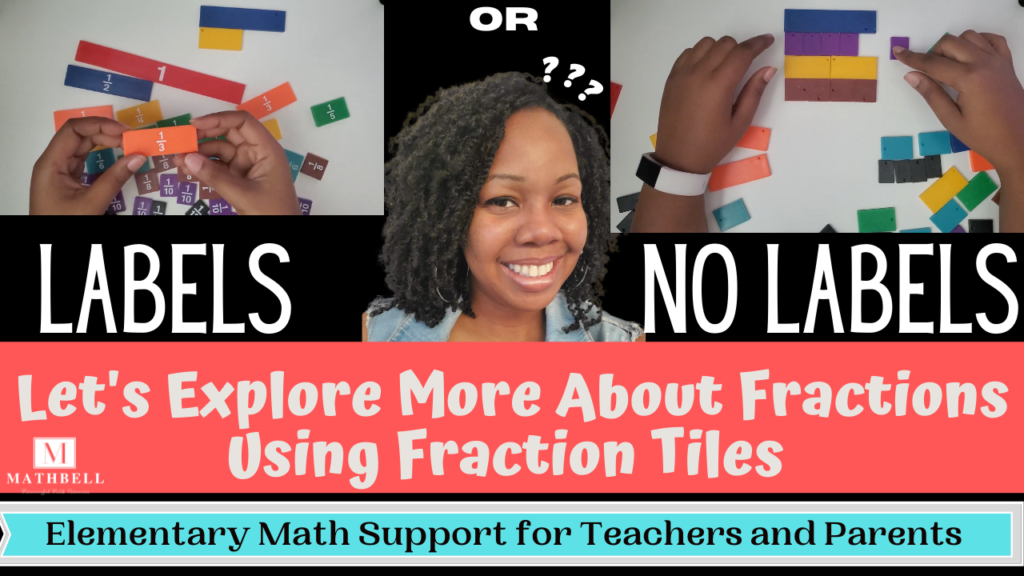
Drawing Pictures
Students should practice drawing their own models after a lot of time working with the concrete models.
This shows that they understand fractions in general, and it is a great way to check for themselves if two fractions are equivalent.
Watch the video Find Equivalent Fractions Using a Model for more examples.

Using the Algorithm
After they have had time for exploration through visual models and make connections and find patterns, most students will begin to learn the algorithm.
When students notice patterns it will lead to discovering the algorithm.
Emphasize those patterns in class or group discussions about what they observe and what they are record in their notebook.
For more details on the algorithm,
Watch Find Equivalent Fractions Using Multiplication or Division.

Word Problems with Equivalent Fractions
Using word problems with equivalent fractions makes understanding them more relatable when they are in context.
Word problems sometimes seem scary but when teamed up with visual models and equations they can help provide more understanding to a concept than just using numbers would.
Finding or creating great word problems is key. Below are some great examples of word problems to check out.
Video: Equivalent fraction word problem example – Khan Academy
Video: Equivalent fraction word problem example 2 – Khan Academy
Website: Equivalent fractions: word problems – IXL Learning
Products: Equivalent fraction worksheets, games, task cards and more – Teachers Pay Teachers
Worksheet for Equivalent Fractions
Use, create, or customize equivalent fraction worksheets on these resourceful websites!
Games for Equivalent Fractions
There are a ton of fun games online that students can play to practice with equivalent fractions. Below I’ve listed just a few that you might want to try out with your students.
Game: Triplets
Website: Math Playground
Game: Equivalent Fraction Games for 3rd and 4th Graders
Website: SplashLearn
Game: Fractions – Equivalent Fractions with Pictures – Online
Website: Mr Nussbaum Learning + Fun
Game: Make Equivalent Fractions
Website: Mathgames.com
Conclusion
Understanding the what and why of equivalent fractions can start out a bit confusing for your students or maybe even you.
Giving the necessary time so that you are confident in teaching this topic to your students and they have enough opportunities to practice should be top priority.
Remember…you can do this and they can too!
Equip yourself with the right tools that aid in your students’ understanding of all things fractions.
Try these:
Pack of Fraction Strips (Printable) or Fraction Strips Kit (Printable and Digital)
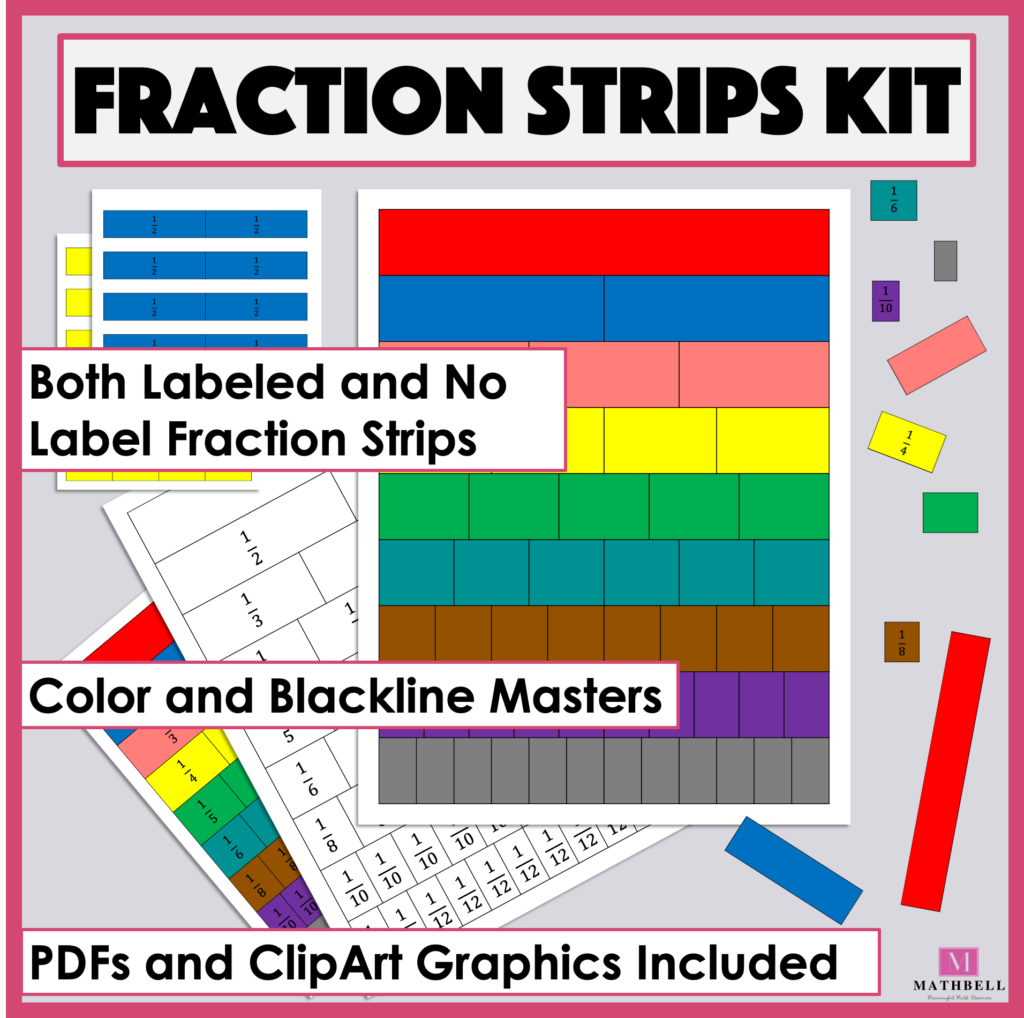
1. Cuisenaire Rods (Plastic Set)
3. Cuisenaire Rods (Small Group Set)
4. Rainbow Fraction Tiles (Plastic Set)
5. Rainbow Fraction Tiles (Foam Set)
6. Rainbow Fraction Tiles (Class Set)
7. Rainbow Fraction Tiles (Blank Set)
8. Rainbow Fraction Squares (Blank Set)
9. Rainbow Fraction Circles (Plastic)
10. Fraction Manipulatives Resource Kit

